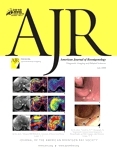Low-Dose CT Method, Delivering 50% Less Radiation, Correctly Identifies Patients With Appendicitis
by Barbara Kram, Editor | July 22, 2009

This study appears in
the July issue of the
American Journal of
Roentgenology.
the July issue of the
American Journal of
Roentgenology.
Patients with possible appendicitis are typically evaluated using a standard-dose contrast enhanced CT, but a low-dose unenhanced CT that delivers approximately 50% less radiation is just as effective, according to a study performed at the Seoul National University College of Medicine in Seoul, Korea. The standard-dose enhanced CT scan delivers approximately 8.0 millisieverts (mSv) of radiation; the low-dose unenhanced CT scan delivers approximately 4.2 mSv of radiation.
A total of 78 patients with appendicitis were all evaluated using both the standard-dose and low-dose methods. CT images were then reviewed by two separate radiologists. Radiologist number one was able to correctly identify appendicitis in 77/78 patients using the low-dose unenhanced method and in 78/78 using the standard-dose enhanced method. Radiologist number two was able to correctly identify appendicitis in all 78 patients using both methods.
"Considering the high incidence of appendicitis in the general population and the rapidly increasing use of CT, small individual risks applied to such an increasingly large population may create a public health issue in the future," said Kyoung Ho Lee, MD, lead author of the study.

 "Low-dose unenhanced CT can potentially be used as the first line imaging test in patients suspected of having appendicitis," he said.
"Low-dose unenhanced CT can potentially be used as the first line imaging test in patients suspected of having appendicitis," he said.
About ARRS
The American Roentgen Ray Society (ARRS) was founded in 1900 and is the oldest radiology society in the United States. Its monthly journal, the American Journal of Roentgenology, began publication in 1906. Radiologists from all over the world attend the ARRS annual meeting to participate in instructional courses, scientific paper presentations and scientific and commercial exhibits related to the field of radiology. The Society is named after the first Nobel Laureate in Physics, Wilhelm Röentgen, who discovered the x-ray in 1895.
A total of 78 patients with appendicitis were all evaluated using both the standard-dose and low-dose methods. CT images were then reviewed by two separate radiologists. Radiologist number one was able to correctly identify appendicitis in 77/78 patients using the low-dose unenhanced method and in 78/78 using the standard-dose enhanced method. Radiologist number two was able to correctly identify appendicitis in all 78 patients using both methods.
"Considering the high incidence of appendicitis in the general population and the rapidly increasing use of CT, small individual risks applied to such an increasingly large population may create a public health issue in the future," said Kyoung Ho Lee, MD, lead author of the study.
We repair MRI Coils, RF amplifiers, Gradient Amplifiers and Injectors.
MIT labs, experts in Multi-Vendor component level repair of: MRI Coils, RF amplifiers, Gradient Amplifiers Contrast Media Injectors. System repairs, sub-assembly repairs, component level repairs, refurbish/calibrate. info@mitlabsusa.com/+1 (305) 470-8013

About ARRS
The American Roentgen Ray Society (ARRS) was founded in 1900 and is the oldest radiology society in the United States. Its monthly journal, the American Journal of Roentgenology, began publication in 1906. Radiologists from all over the world attend the ARRS annual meeting to participate in instructional courses, scientific paper presentations and scientific and commercial exhibits related to the field of radiology. The Society is named after the first Nobel Laureate in Physics, Wilhelm Röentgen, who discovered the x-ray in 1895.










